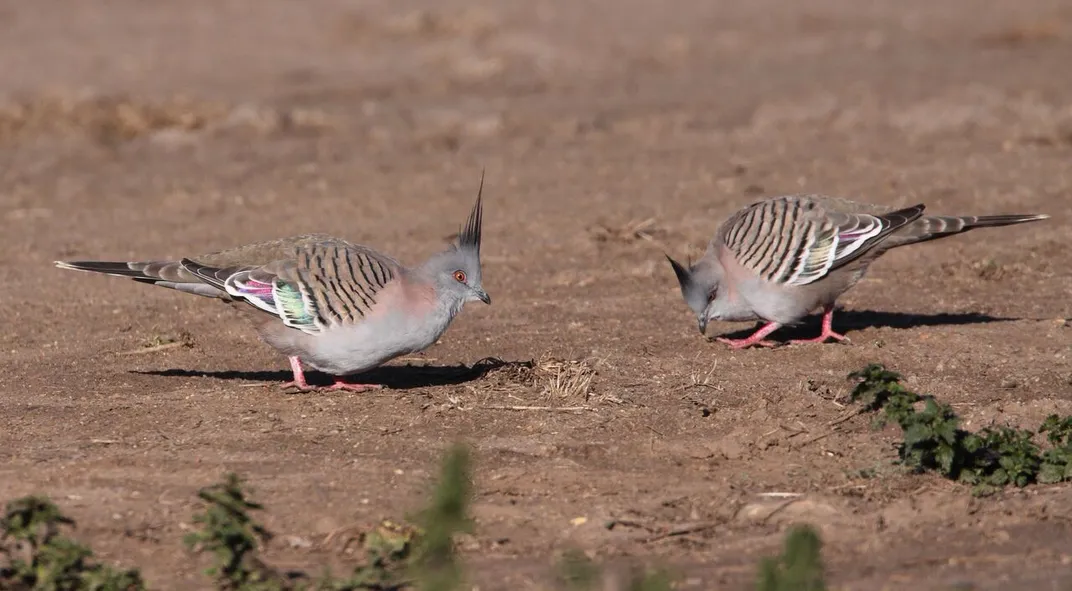Australian Pigeons Have a Specially Evolved Feather to Better Annoy the Heck Out of You With
Pinpointing the birds’ noisemakers could help researchers better understand why urban avians make so much dang noise
/https://tf-cmsv2-smithsonianmag-media.s3.amazonaws.com/filer/66/1e/661e16e1-fde0-4fa1-95f8-5617398edd7f/32985408876_1dc33879c1_o.jpg)
Forget party parrots: When it comes to avian noise-making, crested pigeons are the real party animal. If you've ever heard one scramble frantically to get airborne, you’re likely familiar with the loud, high-pitched whistle they make during takeoff. But you may be surprised to learn that sound doesn’t come from their beaks—it comes from their wings.
The crested pigeon, which looks like a NYC pigeon having a bad hair day (or sporting a really cool Mohawk) is Australia's third-most-common bird. Its wings make a high-pitched whistling sound that is unmistakable, says Trevor Murray, a postdoctoral researcher who studies ecological neuroscience at Australian National University in Canberra.
An individual bird’s wing-whistle is about twice as loud as the average songbird’s call—or 67.6 decibels at 5 meters away, in technical terms—but “if a large flock takes off at once, that can be quite deafening,” Murray says. And they aren’t the only species making noise. Several species of doves—and pigeons, which also belong to the family Columbidae and share so many similar features that the two names are often used interchangeably—make a similar whistling noise.
Murray wondered how exactly these birds managed to drum up such an infernal racket—and why. To find out exactly their noisemakers were located, he took a multi-pronged approach that ruffled a few pigeon feathers. His surprising findings are published in Current Biology today.

A key observation Murray made was that crested pigeons have one wing feather that is noticeably different from all the others: “It’s literally half the width,” Murray says. He suspected that this feather (their eighth) was thinner because it was crucial for generating the noise. For the study, he and his team captured about five dozen birds in a soft mesh trap, recorded their takeoffs, and analyzed the video and sound recordings. Then, for some of the birds, they trimmed off one of their feathers.
Crested pigeons, like prairie dogs, primates and other social animals, seem to listen to each other. When one takes off in a panic, the rest tend to flee too—which makes a lot of evolutionary sense if a predator is about to pounce. But sure enough, recordings of fleeing birds who had had their special wing feather trimmed didn’t cause any other birds to take flight. Meanwhile, recordings of birds who still had all their feathers, or who had control feathers trimmed, did manage to scare the other pigeons.
This told the scientists that there was something very special indeed about this particular feather. Spectrograms of the sound showed that the pigeon’s other wing feathers make a low note, but the eighth feather creates a high-frequency note. This creates a distinctive whistle with a high note, a low note and a clap—caused by the birds literally clapping their wings together.
The crested pigeon is the only species to have a modified feather like this, so it probably evolved pretty recently, Murray says. That suggests that it is something with a distinct evolutionary purpose—a signal, not just a cue.
Lots of animals give involuntary cues to others. “If you see someone rushing through the underbrush, you wonder what they’re running away from,” says Charles Walcott, a professor emeritus at Cornell University who studied pigeons for decades, and who was not involved in the current research. A signal, by contrast, is “produced by an evolutionarily modified structure or behavior and … affects the behavior of intended recipients,” the paper says.
Based on this definition the crested pigeon’s wing-whistle is a signal, one that has evolved because there’s a clear benefit to the birds. “It means both parties gain a benefit,” Murray says. “Not only do the listeners benefit [because they can escape a predator] but if the whole flock scatters at once, than any predator is going to get confused.” The birds are communicating, just with their wings instead of their voices.
There’s one more mystery, though. The crested pigeon may be the only known pigeon to have a specially modified wing feather, but it isn’t the only pigeon to make noisy wing flaps, Murray says. In Australia, for instance, the spinifex pigeon also makes a racket. In the U.S., the mourning dove makes loud noises when it flees that other mourning doves seem to respond to, though it isn’t as loud as the crested pigeon.
Without the specially evolved feather, the sound is different (although difficult for this casual pigeon watcher to detect), as it probably does not have the two alternating notes of the crested pigeon’s alarm signal. “As far as we know that’s actually unique.” Murray hopes, though, that scientists with access to other pigeon species “could go out and record these sounds” to further advance the field of pigeon-wing-whistle research.
Walcott said that Murray and coauthors produced “a neat paper” that was “really well done.” He added that the crested pigeon’s behavior is probably unique among pigeons. “I worked with pigeons for many years, and I haven’t heard anything in particular that I would have characterized as such a signal,” he says. However, he added that most pigeons probably have some sort of wing cue or signal “on a gradation,” by which he means that the line where an involuntary cue becomes an evolved signal is a fuzzy one.
Kind of a lot to think about next time you see a pair of feral pigeons fighting over a pizza crust.